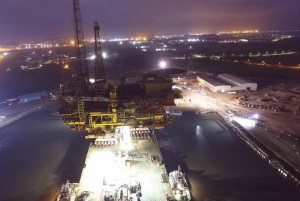Record-Breaking Load-In
 Mammoet successfully concluded the load-in of Shell’s Brent Delta topside at the ABLE UK dismantling yard in Hartlepool (UK). With a weight of more than 24,000t, the structure was the heaviest topside to have ever been brought onto shore in one piece. Because no load-in had ever been conducted on such a scale, Mammoet’s client, Allseas, needed a specialist company that could carry out this operation, which was record-breaking in multiple ways.
Mammoet successfully concluded the load-in of Shell’s Brent Delta topside at the ABLE UK dismantling yard in Hartlepool (UK). With a weight of more than 24,000t, the structure was the heaviest topside to have ever been brought onto shore in one piece. Because no load-in had ever been conducted on such a scale, Mammoet’s client, Allseas, needed a specialist company that could carry out this operation, which was record-breaking in multiple ways.
Shell’s Brent Delta is the largest topside that has ever been retrieved for decommissioning. For the last forty years, the topside has served as a factory, a processing plant and as a hotel for 160 Shell staff members. Bringing the topside safely back onto shore was a complex operation that required more than five years preparation. Within this operation, Mammoet was responsible for the final stage of the operation: bringing the topside onto land. In total, the organisation deployed 436 skid tracks, 64 skid shoes and 36 push-pull units to bring the soccer field-sized topside onto shore. The topside will be dismantled during the next 12 to 18 months. At least 97% of the platform will be recycled and used for other purposes. A new quay has been constructed at Able Seaton Port to facilitate the arrival. It is one of Europe’s strongest quays and represents a EUR 32m investment.
The load-in was not the only record breaking component of the project. Before the load-in, Allseas first had to perform the heaviest single lift ever by removing the Brent Delta topsides with the Pioneering Spirit. Next, the topsides was transported to the port of Hartlepool, where it was transferred from the Pioneering Spirit to the Iron Lady, a purpose built cargo barge on which Mammoet had pre-installed its skidding system. The barge, in turn, was brought over and grounded onto a grounding pad in front of the quay. Preparing the barge ahead of the load-in and grounding her saved a lot of operational time at the decommissioning yard and increased both safety and actual skidding time, which ultimately took only nine hours.






